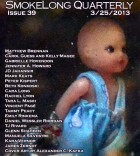How did you get the idea for this piece?
I woke up one morning with the opening line in my head. It was catchy, and it made me curious. It made me consider a lot of things. Matters of the heart and belly. The relationship between hunger for food and hunger for sex. The power of the three paragraph structure. Ideas about consumption. The best kind of story to write—or at least the most cooperative—is the one that presents itself as a simple line with a hint of some complex backstory that it’s the writer’s job to make sense of. The writer is like a detective then. There is the feeling as you’re working that there is a right and a wrong way to write the story, which is a happy fallacy.
What do write aside from flash fiction? How is writing flash fiction different than writing longer pieces?
I write everything except poetry. I like reading poetry, but writing it makes me feel like an elephant in a ballet, or a dancer with two broken legs, or a leg without a foot. I think I am more suited, personality-wise, to longer, more contemplative work. Like many writers, I’ve got a couple of novel drafts gathering proverbial dust in my Dropbox.
It seemed to me that your story touched on the importance of beauty and what beauty means. What is the relation of beauty and its meaning to your writing?
Writing is just the tiresome, endless work of trying to describe, reflect, create, and finally eliminate beauty. I feel I have a funny relationship to beauty. Maybe we all do. Certainly many writers do. In short: I don’t trust it, but I crave it. I just went back to this novel I wrote in grad school for the first time in a couple of years, and re-read all these passages that ended up disgusting me immediately after I wrote it—these lush long descriptions of forests in the rain and cancer and sex that were the reason I’d stuffed it in the back of my computer to gather proverbial dust in the first place—and, to my amazement, I was pleasantly surprised. I thought, “This isn’t so bad—this is okay, maybe. There’s a kernel of truth in here.” But there was a lot of smoke, a lot of mirrors in there, too. Beauty, as they say about life, begets beauty, and you have to be really fucking disciplined as a writer not to let yourself get away with a bunch of distracting, self-indulgent beauty-for-beauty’s-sake. Unless you don’t have a great topic. If your story sucks, by all means write a bunch of beautiful nonsense. Beauty: It’s better than nothing!
If you had to pick one song that reflected your story, what would that be? Why?
How about Woody Guthrie’s “I’ll Eat You, I’ll Drink You.” Because it’s creepy and loving and literal.
If a short film was made about your story, who would direct in it? Who would star in it? Why?
I almost want to say that all films are about my story—or, more realistically, that this story is about all films. All movies, at least. That recent, horrible interview Matt Lauer conducted with Anne Hathaway? “Cannibal” is about that. It’s about how women are consumed—as food or entertainment is consumed—constantly, and everywhere.
I don’t think I could ever pick a real live woman to play the title character in the story. One thing fiction can do that film can’t is tell a story from the point of view of a character who can only be seen in the mind’s eye. And part of what I was interested in doing with this piece was telling this character’s story from deep within her, despite its being about her body, her external characterization. If she were played by a live, flesh-and-blood person, the viewer would be engaging in the same kind of consumption I’m trying to avoid by telling her story directly, from her P.O.V.
That said, I would be giddy with joy if this piece were made into a short film. I think I’d want it to be an animation. Something with a lot of stray lines, where depth and form go in and out of focus, and color goes from lush to absent. The artist who comes to mind is William Kentridge, whose work I love love love … but who wouldn’t be quite right for the story. If there are any animators out there who’d like to take a stab at drawing “Cannibal,” you have my thrilled blessing.
Describe how this story fits into your work overall. What makes it stand out to you?
About five years ago I started writing these weird, short, image-driven stories based on dreams I had. Dream-stories. Most of them weren’t very good, but a few of them seemed like they were this close to revelation, and they all arrived, as this one did, in a flash in the very early morning. Later on, during my last year in grad school, I took a class on flash fiction with the wonderful Jacinda Townsend. I was pretty inspired by my cohort, each of whom did something totally different with the form. I would say “Cannibal,” while not a dream-story, is the closest I’ve come to accomplishing what I have been trying to do since I started writing this way: to tell one story while intimating another, in a demandingly short form. Also, to start with a ludicrous donnée, as dreams do, without explanation.
If you were forced to engage in cannibalism, what body part would you eat first? Also, is “engage” the right verb for cannibalism? If not, what’s a better verb?
That’s a funny question. I think the verb is “eat.”
You’d probably have to start with the toes, wouldn’t you? They’re the most like an appetizer.
Alright, I’ve sufficiently horrified myself.



 The SmokeLong Grand Micro Contest (The Mikey) is now an annual competition celebrating and compensating the best micro fiction and nonfiction online.
The SmokeLong Grand Micro Contest (The Mikey) is now an annual competition celebrating and compensating the best micro fiction and nonfiction online.